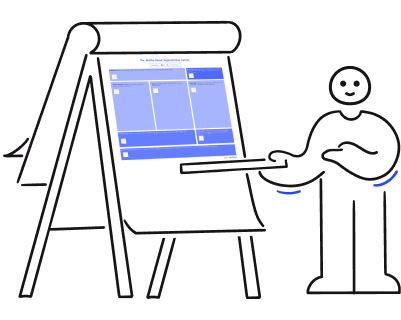Article updated on January 12, 2022
Although we associate it today with COVID-19, working from home was already in vogue long before the confinement.
From 2010 to 2020, remote work had increased by 91%. A pandemic and a few lockdowns later, there is no longer any doubt: it's here to stay.
Whether it is for the flexibility of the schedule, the elimination of daily transport or the possibility of working from anywhere, virtual working is increasingly popular with employees.
But does this freedom mean a drop in production? Not necessarily.
The key to maintaining an effective and productive remote team is to cultivate engagement proactively.
This is as true for our former employees as it is for our new talents!
What makes the challenge even more significant in a hiring context is that you must first build a new relationship. And the scale of the challenge is shared between the employer, wanting to provide the best onboarding experience, and the employee who wants to feel welcomed and accepted.
That's why it's essential to build onboarding programs that support our employees remotely. These programs must then be adapted to the distance context to maximize their effectiveness.
Discover in this article 5 tips to cultivate the engagement of new remote employees.
Empower your organization with the skills-based canvas.

What's in this article
- 1. Understanding the basics of an engaging onboarding program
- 2. Provide the necessary materials in advance
- 3. Keep onboarding sessions short and simple
- 4. Create opportunities for interaction with their colleagues
- 5. Plan hybrid work sessions
- Cultivating our remote employee engagement even after onboarding
1. Understanding the basics of an engaging onboarding program
Onboarding our employees is a pivotal element in staff retention.
Whether in person or remotely, onboarding is a pivotal period to generate engagement with our new employees. Three basic principles must be respected during the onboarding process.
Establishing a relationship of trust
What can we do to gain the trust of our employees? Of course, transparency is a good starting point. Trusting in return works great too. Demonstrate that we recognize their past experiences and their professional value.
Create a sense of belonging
Being part of a group or team brings an additional dimension to commitment. Therefore, onboarding must collaborate with other people to create a sincere and authentic connection.
Communicate effectively
What are our common goals? Let's share our vision with our new team and use effective communication methods. The clearer the message and the easier the information is to find, the more we move in the right direction.
2. Provide the necessary materials in advance
How can an employee be expected to do his job if he does not have the necessary tools?
This includes virtual tools, such as access to email and the company intranet, and physical tools such as their computer or a desk.
Onboarding will be much easier by providing our new employees with all the materials they need before the first day of work. They will already be comfortable and designate a suitable workspace at home.
And why not add one or more items to the corporate image? This will make them feel already welcomed into their new team.
This inclusion directly contributes to establishing this relationship of trust that nurtures the commitment of our remote employees.
3. Keep onboarding sessions short and simple
We tend to fill our new hires' heads with information about everything related to the company to maximize their training time.
This is very rarely the most effective method.
We can spread the onboarding training over a few days or even a few weeks to release their mental burden. HCI had found that when companies limit their onboarding program to the first week, new hires feel confused, discouraged, and lacking resources.
The ideal is to segment the learning to follow the same theme each week.
Alternating between different learning activities also helps engage our remote employees.
Rather than chaining pre-recorded videos, let's break up the sessions with readings, exercises and follow-up calls. This will allow our new talents to practice their skills and give themselves the means to memorize them in the long term.
4. Create opportunities for interaction with their colleagues
In a traditional onboarding program, one of the first steps is to make the famous office tour.
Although it may seem trivial, it is crucial to present our new talents and create curiosity among our existing staff.
Forbes found that 21% of remote employees feel lonely and isolated.
Therefore, during the remote onboarding, it is crucial to generate opportunities for exchange between the new resource and his colleagues. It should even be an integral part of the onboarding process!
Besides follow-up calls and virtual coffees, pairing lends itself very well in a training context. Let's give our new employees the chance to spend time with a senior to work together on real cases.
There are so many tools that make communication and engagement more accessible. We just have to find the ones that best suit our business and train our employees to use them optimally.
5. Plan hybrid work sessions
It can seem counter-intuitive to have remote employees move to our offices.
However, hybrid work allows you to get the best of both worlds!
According to Help Scout, “Quality face-to-face meeting time is a great way to support a successful transition to a business that operates remotely. So we try to send people to Boston (where 25% of our team is located) for their first week.”
Chargify does the same: “Onboarding can be done remotely, but new hires often meet in person with their immediate supervisor. It can be a good introductory technique to meet face to face when onboarding to add a personal connection.”
It is also an opportunity to spend time with their colleagues for new resources. This helps to develop a strong sense of belonging, leading to a more sincere engagement of our remote employees.
It's also direct exposure to the corporate culture and one of the best ways to embrace it quickly.
Cultivating our remote employee engagement even after onboarding
Setting expectations around scheduling, engagement, and workload is a critical step in completing the onboarding of our remote employees.
This provides them with a secure framework to build their work-life balance.
One of the best benefits of working remotely is the flexibility to live a life that our employees are passionate about. By defining expectations from the start, we give them the means to take advantage of them while maintaining their productivity!
The objective is, above all, to make employees happy by providing them with an engaging and stimulating work environment.
With the amount of software available these days, it is now possible to create this atmosphere even with our remote teams.
Workleap LMS is one of many tools available to simplify internal communication, knowledge sharing and process documentation!
Discover, manage, and grow your team’s skills to unleash their potential and retain your rising stars.




